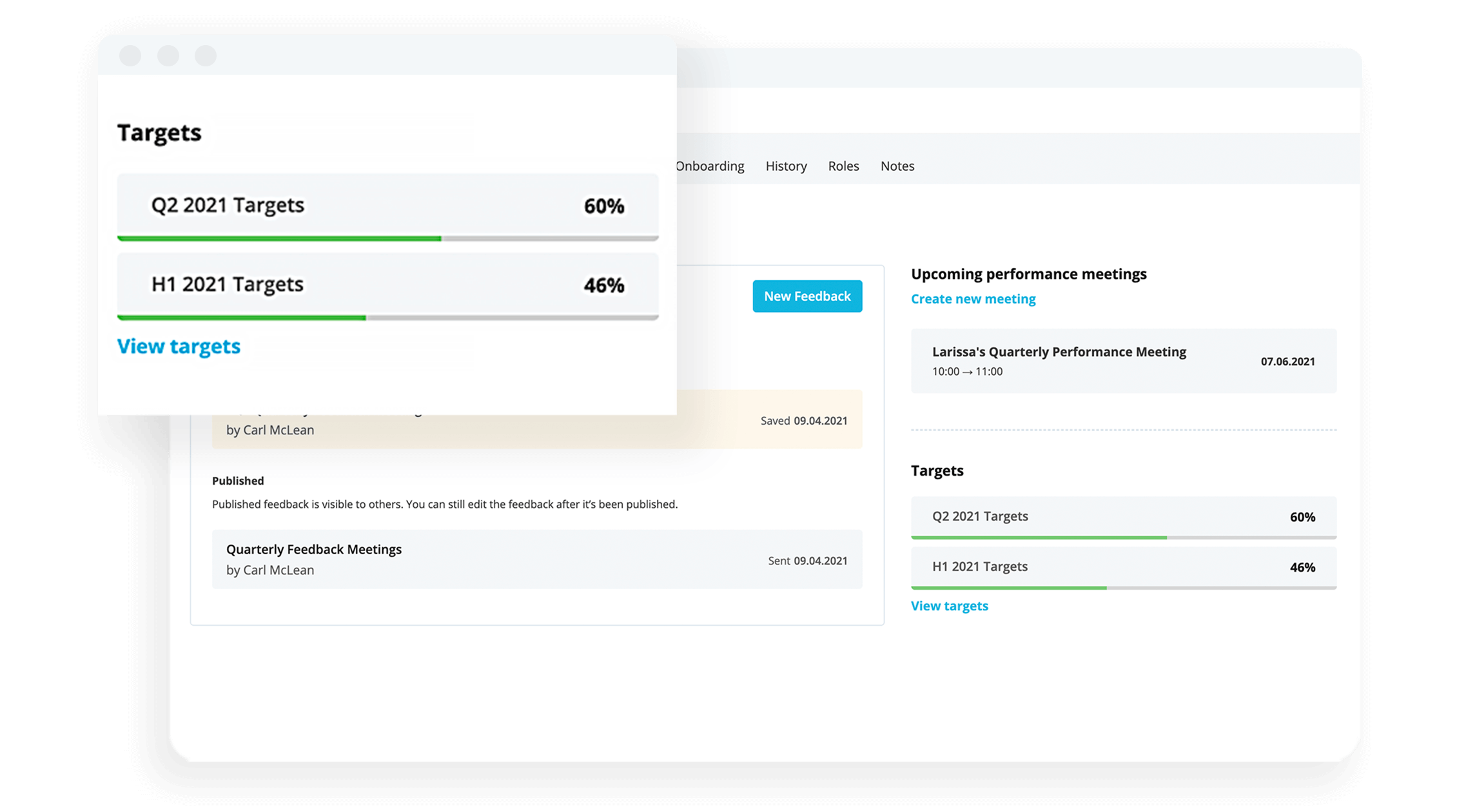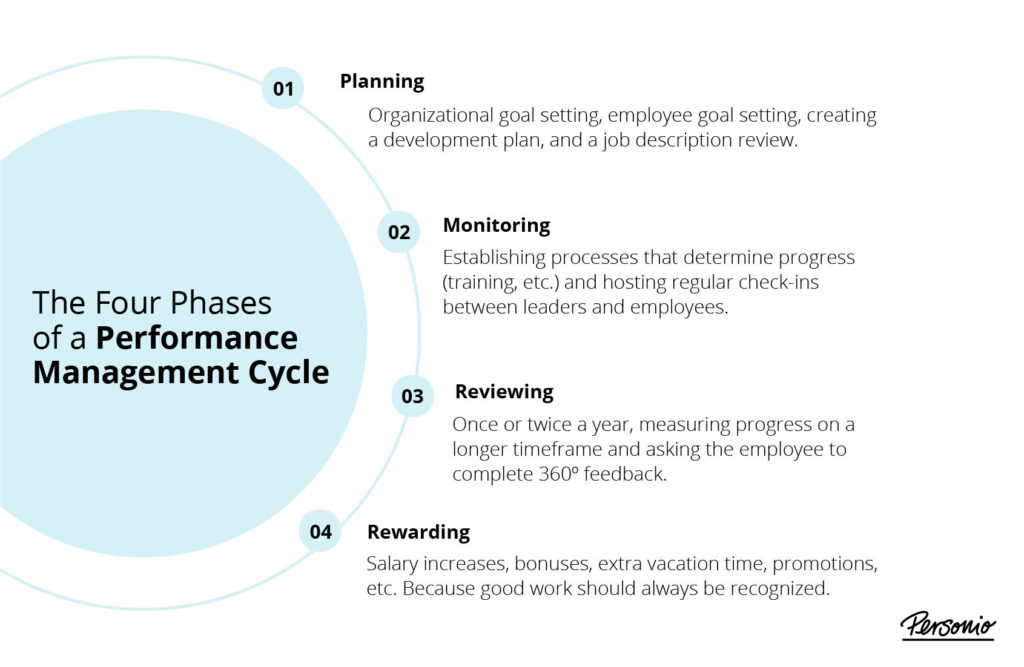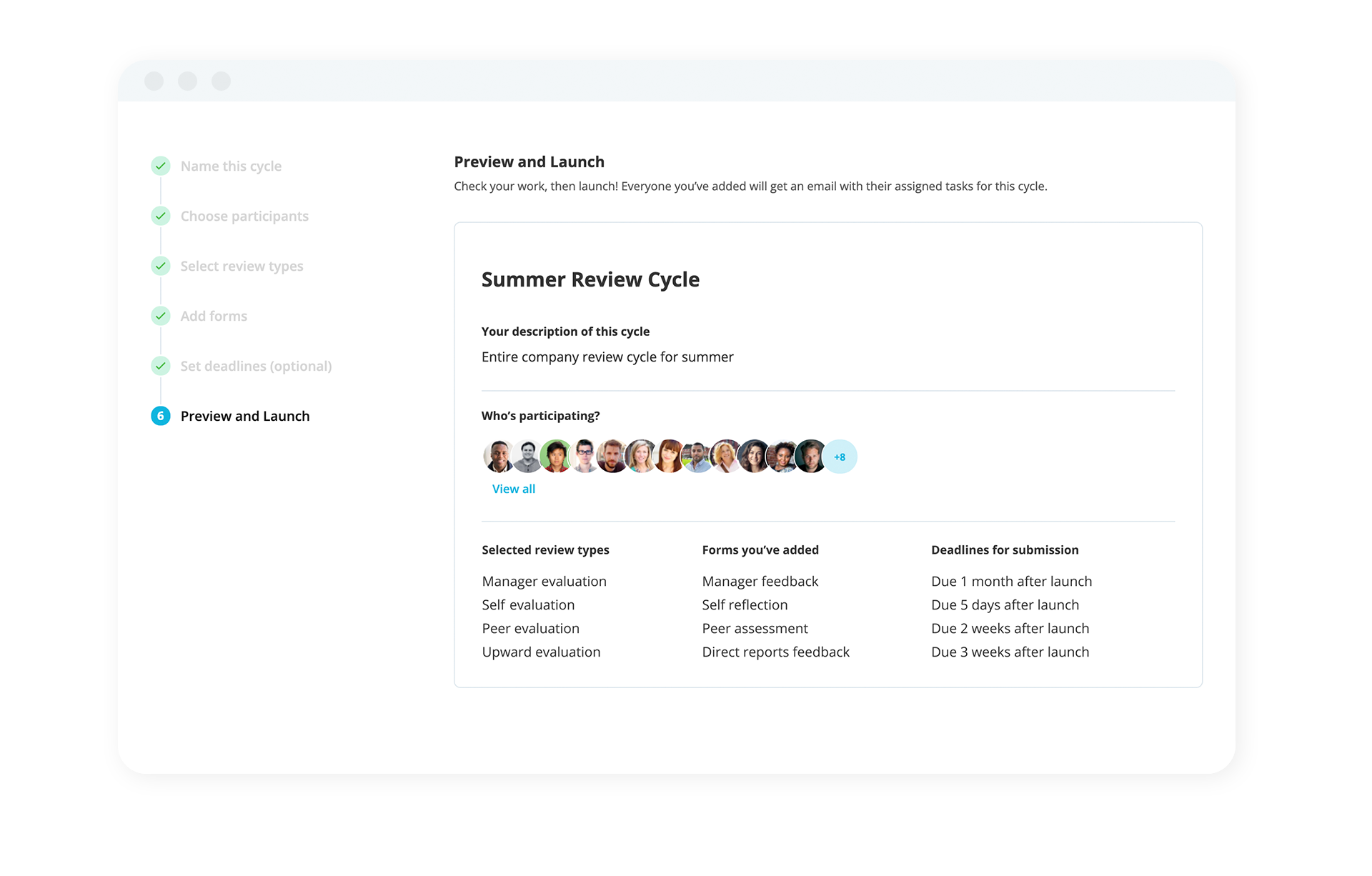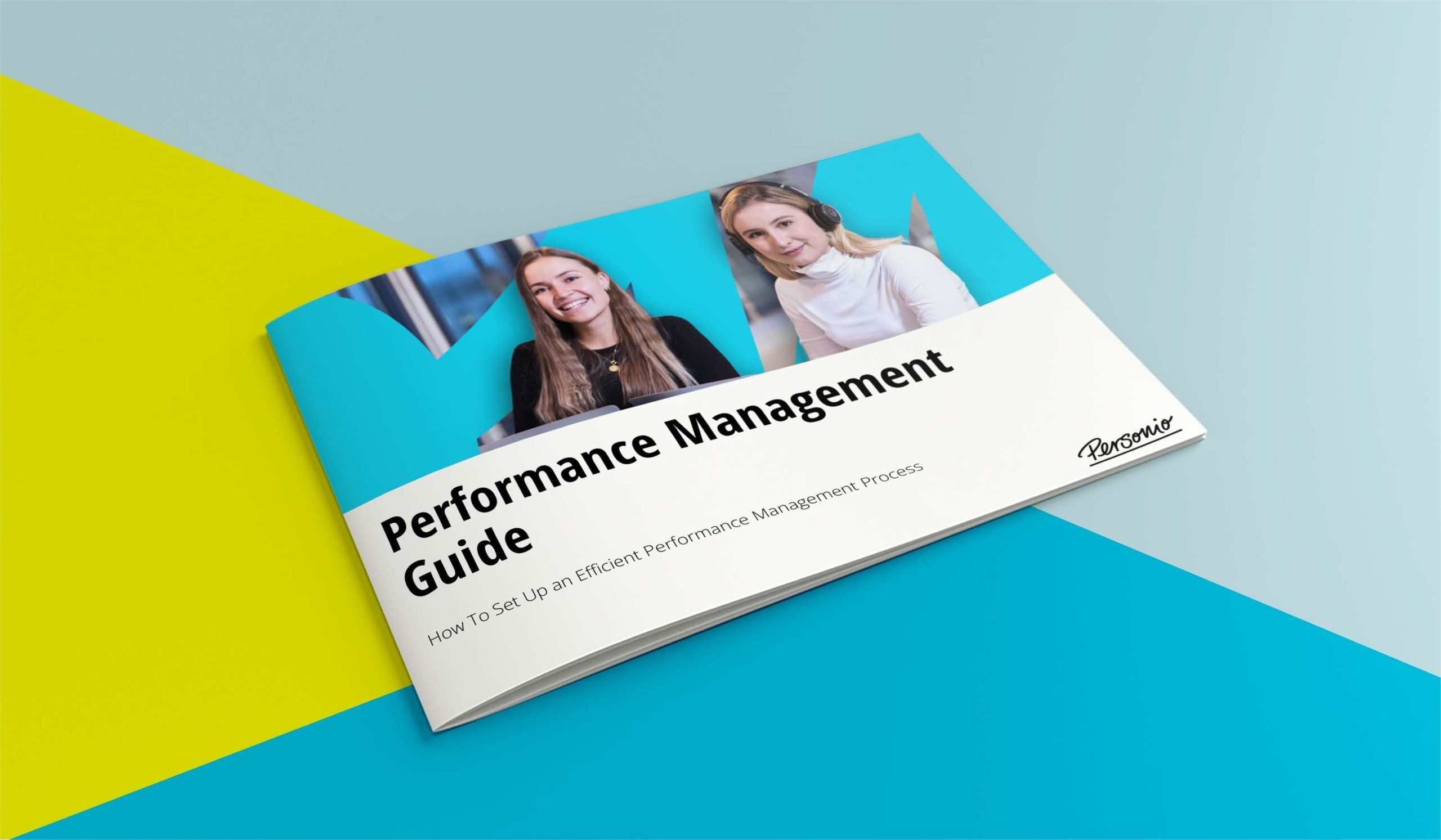What’s the benefit of a fully automated performance management cycle? Well, not only is it easier to initiate and carry our performance talks with employees, but employee performance can actually go higher than ever before.
How? In this article, we’ll dive into the performance management process, best practices into how it’s done, and how to build a cycle that stands the test of time. You can check out the full breakdown by scrolling down below.
Download our latest Performance Management Guide today.
Contents
What Is Performance Management?
What Is The Performance Management Process?
What Is A Performance Management Cycle?
The Four Phases of a Performance Management Cycle
How Do You Establish A Performance Management Process?
What Is A Performance Management Framework?
Performance Management Cycles: Best Practices
Strategic HR & Performance Management
What Is Performance Management?
At its core, performance management is about aligning the performance of any given employee with the overall success of an organisation. This could include helping employees improve in their day-to-day work, work on their key skills, recover from a low point, or continuously develop in a cyclical fashion (more on that last one later).
What Is The Performance Management Process?
The performance management process is how an organisation seeks to steer employee performance. Basically, it sets the foundation for performance management: how often employees are evaluated, how they are evaluated, and how evaluations can occur in a consistent and unbiased fashion.
The Four Key Components Of The Performance Management Process
All four components of the performance management process are interconnected. And, in a best-case scenario, they can even boost one another. They include:
| Key Component | Why It Matters |
|---|---|
| Culture | The way employees are motivated by their surroundings to improve. |
| Open Communication | Transparency as a method for boosting performance. |
| Skilled Leadership | Leading by example and motivation through appreciation. |
| Employee Skills & Interests | Coordinating both so employees improve and like what they see in themselves. |
What Is A Performance Management Cycle?
A performance management cycle is a continuous improvement process for planning, checking and measuring employee performance. It works in a way that meets the overall goal of performance management: aligning the success of employees with the success of an organisation.
During a performance management cycle, a manager works with each employee to:
- Set appropriate and impact-driven goals.
- Explore how the employee can achieve their goals.
- Provide the resources and support to put the goals into action.
- Review and reward performance (typically against those goals).
Taken together, this allows a performance management cycle to function as a holistic process and to deliver top results from employees.
Introduce A New Era of Performance Management
Performance & Development with Personio can unlock a new era of developing your top talent.
Why Use a Performance Management Cycle?
Simply put, performance management cycles improve a company’s overall success.
These work in two unique ways:
- They help boost engagement by enabling employees to reach their potential and have greater involvement in their professional development.
- They help increase productivity by aligning the work goals of each employee with the strategic goals of the organisation.
Close collaboration between employee and manager, plenty of feedback, opportunities for growth, and recognition for good work are attributes of performance management cycles.
And, all are shown to have a positive impact on employee engagement. Therefore, it helps to think of a performance management cycle as part of an overall performance management framework for your organisation.
The Four Phases of a Performance Management Cycle
Although there are plenty of variations to the process, most companies use a performance management cycle consisting of four distinct phases.
These steps may have different names, but they generally follow the same logic flow of phases:
| Phase | Key Component |
|---|---|
| Planning | Organizational and employee goal setting. |
| Monitoring | Hosting check-ins and keeping on top of KPIs. |
| Reviewing | Measuring progress on a yearly or biannual timeframe. |
| Rewarding | Salary increases and other rewards to retain top talent. |
Let’s dive into each one of these separately.
Performance Management Cycle Phase One: Planning
Let’s consider planning as an overarching concept. That’s because this phase actually has several distinct steps:
- Organisational goal setting
- Employee goal setting
- Creating a development plan
- Job description review
Need to take a quick step back? Here’s how to develop a performance management process.
Performance Management: Overall Guiding Goals
First and foremost, the organisational leadership team needs to establish the goals and objectives for the organisation for the period covering a performance management cycle. This usually involves a year or half-year.
This is an absolutely crucial step. That’s because all team and employee goals are then tied to this, on top of adding an overall vision and goal to the timeframe ahead.
It is this alignment that enables companies to perform at their best. To use an analogy, a boat moves fastest when all the rowers are pulling in the same direction.
Having SMART Goals
Next, the employee and manager work together to set the employee’s individual performance goals for the period. Most businesses follow the SMART goal-setting framework (specific, measurable, achievable, realistic, timely) to do this.
Goals should allow employees to improve existing skills and develop new ones. Remember that the company’s objectives are feeding into this process, so every goal should clearly demonstrate how it is contributing to at least one of these objectives.
Personal Development a Priority
Now that the goals are established, the employee and manager can create a personal development plan for the period. This includes skills, knowledge, and behaviors an employee needs to grow in order to be able to achieve the overall goals.
If, for example, one goal is to create a detailed analysis of sales performance for the previous year, the employee may need training in an analytical tool.
Or, if a goal is to improve communication gaps between the employee and another stakeholder, the employee may need to commit to ways to do this.
A development plan also includes plans for future growth. Of course, this also needs to take into account the employee’s own career goals.
Role Review
Now that the goals are established, the employee and manager can create a personal development plan for the period. This includes skills, knowledge, and behaviors an employee needs to grow in order to be able to achieve the overall goals.
Performance Management Cycle Phase Two: Monitoring
Some businesses prefer to call this phase “Acting” or “Performing.” That is because it is essentially the period in which employees are actively working on their goals as part of their day-to-day tasks.
During this phase of the performance management cycle, an employee also takes on some kind of training. Or, they undergo other parts of the development plan for the period.
Part of the manager’s role, then, is to ensure that support and resources are available. This is to enable the employee to carry out the work according to the plan.
An equally important management responsibility here is to do regular check-ins with the employee – ideally monthly — to monitor progress.
This isn’t micromanaging but ensuring that the goal can be achieved within the targeted time frame. In addition, identifying potential problems before it is too late.
What Should You Cover During A Progress Check-In?
Here are some topics and prompts that you can cover during a performance check-in:
| Subject | Prompt Question |
|---|---|
| Accomplishments | What are you most proud of over this time period? |
| Progress | Are we on track to hit our goals? Why or why not? |
| Roadblocks | What is getting in the way of hitting our goals? |
| Changes | Do we need to revise our goals based on roadblocks? |
| Support | How can I help you hit these goals or shoot past them? |
| Recap | How would you say your performance compares to this time previous? |
Build Automated Performance Cycles Today
Book a demo today and a Personio expert can show you how to make building automated performance cycles a breeze.
Performance Management Cycle Phase Three: Reviewing
Reviewing is usually done once or twice a year.
Whereas monitoring consists of short, focused check-in meetings on goal progression, reviewing takes a step back and measures progress on the employee’s overall development plan for the period.
It looks not just at the status of the goals in the plan, but also at overall performance, key learnings, and career development.
A key part of a review is performance assessment and feedback. In addition to a self-assessment, employees may want to consider doing a 360° feedback process, which includes input from their peers and manager.
This collective feedback provides the basis for a constructive review, which should be a two-way discussion. The employee should evaluate his or her own performance as well as give and receive feedback on the team and the manager.
Some common discussion questions for a review are:
- Were the goals achieved? If not, why?
- How well did the employee perform the tasks?
- What should be done differently / the same going forward?
- Did the employee get the support or resources needed to achieve the goals?
The review is also the time to talk about the employee’s future development opportunities. It is not simply a critique of what happened, but what was accomplished, what challenges occurred, and what the roadmap should be for the future.
Help employees get better at what they do with a performance improvement plan (PIP).
Performance Management Cycle Phase Four: Rewarding
Good work should be recognised. That’s what this step is about.
It’s important to tie rewards directly to performance, ideally within the period of the performance management cycle. That’s because employee motivation turns heavily on being rewarded.
One global study found that engagement jumps over 40% when employees are recognised for their work. If companies want to establish performance management cycles as part of their strategy successfully, this final step has to be there, and recognition needs to be meaningful.
What Are Common Ways To Reward Employees?
The most common ways to reward an employee include:
- Salary increases
- Bonuses
- Public recognition (e.g., awards, privileges)
- Extra vacation time
- Being able to take part in a special program or project
- Promotions
How Do You Establish A Performance Management Process?
Ideally, your performance management process should be bolstered by software of some kind. This way, performance cycles can happen in an automated fashion, where employees and managers alike are instantly notified and able to submit feedback and self-reflections with ease (and with helpful reminders).
This then allows development discussions to happen more frequently. Ultimately, 12 months of performance can’t be measured in one single meeting; the cognitive performance ends at 2-4 months. So, feedback should:
- Be given in suitable portions.
- Relate to a specific occasion or event.
- Occur frequently.
What Is A Performance Management Framework?
Pulling back a bit, a performance management framework is having a foundation for optimal performance in your organisation. A cycle may be the steps, but the framework is your guiding light when it comes to managing performance.
Think of it like this: A performance management framework seeks to establish the competencies of roles, the indicators that determine their success, the current training programs that can lead them to success, and the continuous training they can undergo to get even better down the road.
Start putting a framework in place with Personio’s help today.
Performance Management Cycles: Best Practices
Setting up the process for performance management cycles at your company is a huge effort. So, you want to make sure it’s effective. What are some performance management best practices you can implement along the way?
| Best Practice | How To Do It |
|---|---|
| Make Time | Planning, check-ins, reviews, etc. are time-consuming. Support for this process has to start at the top. |
| Tie Coaching In | Managers should see themselves as coaches for their employees, and act accordingly. |
| Continuous Development | A cycle is a never-ending process and has no clear beginning or end for a reason. |
Strategic HR & Performance Management
Thinking about a performance management framework or developing your own performance management cycles? When done well, each new cycle should be more effective than the last, but you need the time to focus on those tasks.
From the core elements of performance management to storing data and handling administrative tasks, or generating reports at the click of a button, Personio can help. Click the button below to find out how it’s done.
Custom & Automated
Performance Cycles








